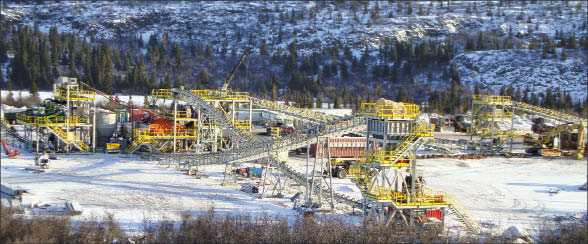As the acquisition of Quebec-focused iron ore producer Consolidated Thompson Iron Mines (CLM-T) by resource giant Cliffs Natural Resources (CLF-N) finally comes to a close, investors can’t help but wonder which company in the area is next in line to be sold to a global iron ore or steel powerhouse.
Three majors currently operate iron mines in the area comprising the Labrador Trough – a more than 1,000-km-long, 160-km wide geologic belt extending from northeasternmost Quebec through to western Labrador.
Rio Tinto (RIO-N, RIO-L), through its majority ownership in the Iron Ore Company of Canada (IOC) consortium, is the area’s largest producer of the key steelmaking ingredient. It is closely followed by global steel giant ArcelorMittal (MT-N), which controls the Mont-Wright and Fire Lake mines, and finally by Cliffs, which just added Consolidated Thompson’s Bloom Lake mine to its nearby Wabush operations.
With the price of 62% iron ore rising steadily from around US$15 per dry tonne in 2004 to its current rate according to Platts of US$181 per dry tonne, competition for scarce resources has heated up, and a swath of juniors are vying to capitalize on the opportunity.
The closest to becoming a producer is Labrador Iron Mines (LIM-T), which expects to begin operations at its Schefferville area project later in the second quarter of 2011 at a rate of around 3.65 million tonnes of ore per year. The project comprises 20 direct shipping iron ore (DSO) deposits located 2 km to 65 km from the town of Schefferville, Que., that form part of the historic iron ore mining operations once found in the town dating back to the early 1950s, when they were operated by the IOC.
Labrador Iron Mines has rail service agreements in place, has arranged for port facilities, and has just raised $110 million to complete its transition into Canada’s newest iron ore producer. It currently trades for around $11 a share, down slightly from its all-time high of $14.95 in early April, but still well up from the $4 it traded at last summer.
Next up is New Millennium Capital (NML-V), which has a $300-million agreement with Tata Steel to develop its similarly named Schefferville DSO project, straddling the Quebec and Labrador border. Tata is financing the project and will end up with an 80% interest and all the off-take. The partners expect the 29-deposit operation to produce four million tonnes per year beginning some time in 2012.
More importantly, New Millennium signed a binding heads of agreement in March with the major Indian conglomerate worth up to $4.9 billion. Tata has agreed to pay about $32 million initially toward the completion of a feasibility study for New Millennium’s nearby Taconite iron ore project, comprising the LabMag and KeMag deposits. Tata will then decide whether to enter a formal joint venture agreement to develop one or both deposits, leaving New Millennium with a 20% free carried interest. Tata currently holds a 19.9% interest in the junior.
In a similar vein, Adriana Resources (ADI-V) signed a $120-million strategic partnership agreement in January with China’s Wuhan Iron & Steel Corp. As part of the deal, Wuhan took a 19.9% interest in the company. In April, Adriana released a preliminary economic assessment for its main Lac Otelnuk iron ore project near Nunavik, Que., in the north-central part of the Trough. It pegged the net present value of the project at $15.2 billion and forecast a 50-million-tonne-per-year operation, assuming the company can first build the 815 km of required rail lines and then vastly expand nearby port capacity.
As yet without a joint venture partner is Alderon Resource (ADV-V), run by the Toronto-based Forbes & Manhattan group. Forbes has experience in the area though, being the management company behind Consolidated Thompson before its recent sale.
Alderon hopes to delineate a more than 1-billion-tonne resource soon at its Kami iron ore project near Labrador City. Kami is just 6.4 km from Consolidated Thompson’s Bloom Lake mine, 4.5 km away from a common carrier railway, 15 km from a hydro power station and could have access to four separate ports. An initial resource estimate for the project outlined an indicated resource totalling 490 million tonnes at 30.3% iron, as well as inferred resources totalling 118 million tonnes at the same grade. Alderon notes the grades are similar to those found at Bloom Lake. The company’s largest shareholder with around a 40% interest is Altius Minerals (ALS-T), which spun off the project to Alderon in late 2009.
In the southern part of the belt, near Fermont, Que., lies the majority of Champion Minerals‘ (CHM-V) property holdings, most notably its Fire Lake North, Bellechasse and Harvey-Tuttle projects. The three combined host inferred resources of 1.55 billion tonnes grading 25.4% iron. At the northern end of the Labrador Trough, near the Ungava area of northern Quebec, Oceanic Iron Ore (FEO-V) has a smattering of historical properties that were explored during the 1950s and 1970s but were never developed, in part because of the area’s remoteness. The company is completing a drill program there to bring historic resources of 2.68 billion tonnes grading 32.7% iron up to National Instrument 43-101 standards.
Lastly, newcomer Cap-Ex Ventures (CEV-V) has picked up projects near Labrador Iron and New Millennium’s main projects. It recently raised $12.7 million for a 10,000-metre drill program on its most-prospective property, as well airborne surveys, sampling, geophysics, metallurgical testwork and a preliminary resource estimate.
It’s already shaping up to be one of the most active years yet for the Labrador Trough, with more corporate deals and resource expansions likely still to come.


Be the first to comment on "Forging deals in the Labrador Trough (May 23, 2011)"